Notes on Poker (Updated)
Contents
- Should I Be Playing
- River: Calculating EV
- River: Holding the Nut Advantage
- Preflop + Multiway
- Part 1: Choosing a Subset of Flops & Range
- Part 2: Flop, Turn, and River (Exact Flops x Exact Ranges)
- Multiway
- Being Humans
- Results and Reflections
There is also intentionally no solver use in this post. Poker is a dynamic game, and knowing what the right answer is isn't really good for understanding or being able to develop an adaptive strategy. I think some sections like sections 5 and 6 drag a bit too long. Feel free to skip those.
The most valuable nuggets of wisdom is probably in section 9, the most recently written section.
I have also deleted my previous posts on poker for neatness.
Some references I mention: (mpt, tmop, online videos).
1. Should I be playing
Poker attracts some of the brightest people and also some of the most degen people.
Don't play if it's not fun. Unlike going on a hike or painting, playing poker has the result of definitive losers and winners. The money element also exacerbates the psychological aspect of the game. I don't play this game for months when I feel like I'm being burdened/tilted.
Don't play if the cost of playing affects the decision making. Low volume poker is extremely high variance. High volume poker is low ROI. So yeah, it's a grindy game. And some people try to cheat the grind by playing higher they can afford to. Have you ever seen people losing it all on black in Vegas? Yeah, playing beyond your means is a recipe for disaster.
Being lucky (low volume) is nice, but bankroll management (high volume) lies at the heart of this game for players with long term goals. So how much money should I have to play? We can't make any bets if we don't have money. Risk of Ruin is the probability that the bankroll becomes 0, and therefore becomes ungrowable regardless of how much edge you have. This hacker news post called How to Size Bets is a pretty good read. (And also part IV of tmop.)
By calculating the Risk of Ruin, we answer questions like "how much money should I have to play poker indefinitely?" or "are these games too big for me?"
I personally vouch for just taking a sample of your last n sessions, getting a mean/variance, and seeing how many standard deviations we are from the mean.

For example, the results of my last 25 games are -30, -30, -20, -20, -20, -20, -15, -15, -15, -10, -10, -10, 0, 0, 0, 5, 5, 15, 15, 20, 20, 50, 130 units, which gives me a sample variance of 1136 and mean of +1.9. Therefore, we can calculate the risk of ruin:
R(100) = 0.72 (risk of losing everything is 72%)
R(1000) = 0.035
R(2000) = 0.001
How much units of money should I have to play poker, assuming my variance and games don't change? 1200 units maybe.
An afterthought: most poker game winnings don't follow a normal distributions. In tournaments, only the top places get paid. In cash games, people tend to only have a stop limit when losing, some casino have max buy-in sizes, etc. For more accuracy, you can solve for the risk constant in the more generalized form. There are examples in tmop.

2. River: Calculating EV
I want to calculate the EV from the river and see if there's any potential exploits. We'll use the example below.
Example
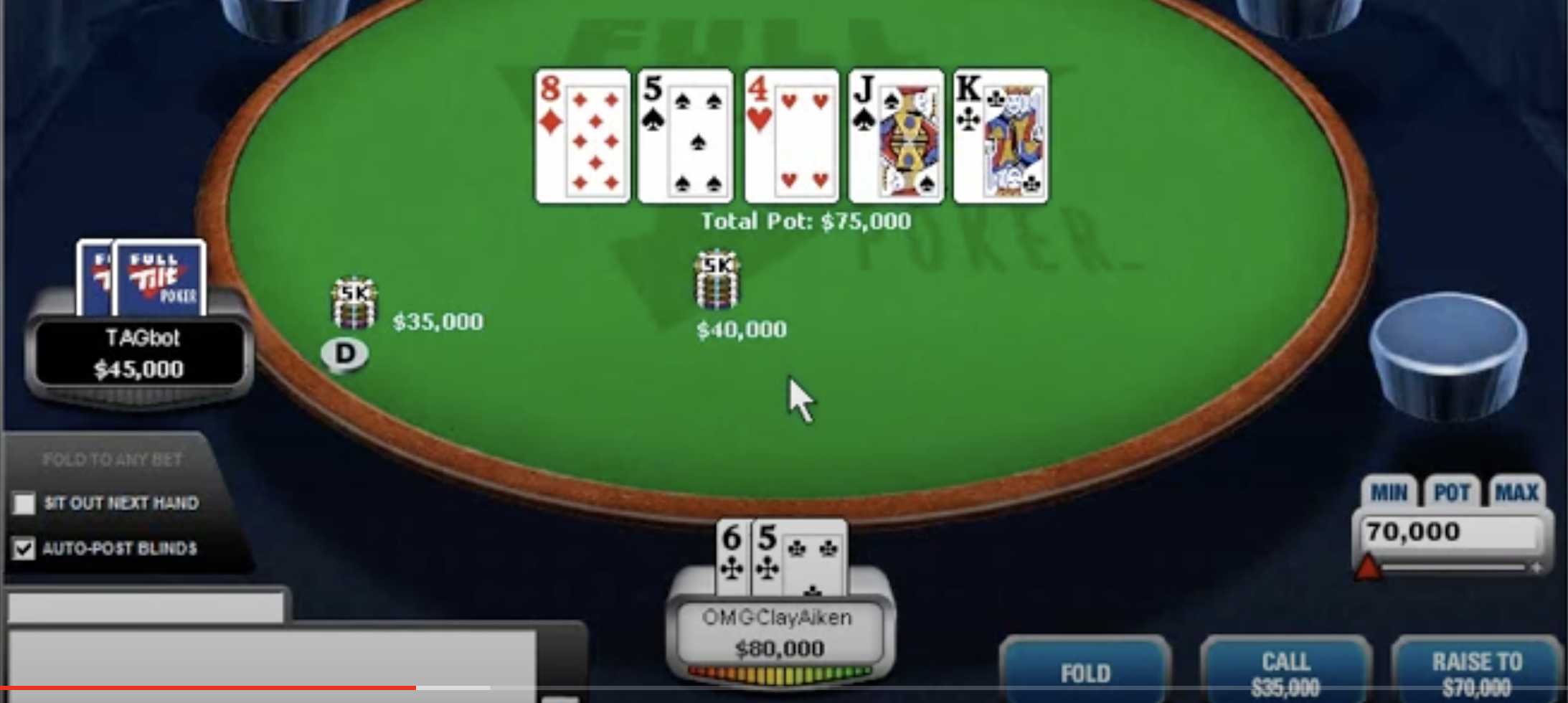
I really like this example by Phil (this video). It shows how betting on draw-heavy boards that doesn't hit makes a hand weaker. We'll look at hand combos and calculate EV for this example to get a good understanding of ranges.
- TAG villain opens 3bb from the button. Hero calls.
- Villain is checked to and bets on a [8d 5s 4h] board. Hero calls.
- Flop is [Js]. Villain is checked to and bets. Hero calls.
- River is [Kc]. Villain is checked to and bets pot. Hero is at decision point and calls with 6c5c.
Phil makes the argument that there are so many draws that missed. The scare card K on the river is just a convenient excuse for the opponent to to turn drawing hands into bluffs.
My check/value/bluff are constructed to make sense for me, and so they are a little different from Phil's, but the general idea is the same; there are a lot of bluffing candidates given our villain's proclivity for betting too many draws. We are also making the assumption that villain is not betting hands like A5 or 89 for three streets to get to showdown.
If villain value bets with
- 88, 55, 44, JJ, KK (15),
- 67 (6),
- K7 (12), K6 (12), QQ (6), AA (6)
- maybe J7 (12), J6 (12)
- two pairs include 8J (9), 8K (9), 54 (9), KJ(9)
- let's be nice and say maybe 90 hands
Bluffs with:
- 6X, 7X that don't hit (This is highly variable, but maybe 125 hands)
less than all 6X, 6X hands, but more than just the suited combos, removing some 96o, T7o, 62s, 72s, etc. including all 6x, 7x hands that don't hit is like 180 hands - and some non 6X, 7X flush draws
- let's be nice, and say it's 120 hands
What's our EV of calling villain's pot-sized (p) bet?

Knowing villain's value hands and bluffs, we can calculate:

We're printing money from this exploitative call because villain is bluffing too much!
In this example, villain betting with all the 90 value hands, and we'll consider all these hands nutted, and villain should employ a bluffing strategy with air such that Player 2 is indifferent to calling and folding with a bluff catcher. What ought to be the bluffing frequency?

The bluffing frequency is therefore 1/3 (and value frequency 2/3). If $\frac{b}{2b + p}$ is the breakeven bluff frequency, then $\frac{b + p}{2b + p}$ is the value frequency, then we solve for the bluff to value ratio, we get:

For villain's 90 value combos, villain should pair it up with 45 bluffing combos to breakeven.
Villain's bluffing frequency is the same as hero's pot odds.

To use the clairvoyant toy game from MPT into this example (pg. 70 of MPT), let's instead simplify our opponent's range as either having nuts at 90 hands (33%) or air at 120 hands (66%). We only have a bluff catcher. I know, I know, this is not accurate. Hero's range isn't only bluff catchers; hero's options are not only to call and fold (hero has hands in range that can raise), and nobody really has 90 nutted hands; in the above case, though villain has more overpairs, ranges are otherwise symmetric, but both players have pretty much the same proportion of very strong hands.
Let's just assume that villain has 90 combos of nuts and 45 combos of air (pot sized bet) for simplicity. Hero should defend at MDF (minimum defense frequency -- (I'm omitting some due diligence here but is on page 77 of mpt)). Otherwise, if villain is bluffing less, we should defend less.

So should we be making the call?
If we are confident about our mental model that villain is bluffing many 6X and 7X hands that missed, yes. Our call isn't just plus EV, it's VERY plus EV.
Otherwise, probably no. Assuming our opponent is at least bluffing enough, after a flop defense (let's say pot size), and after a turn defense (let's say pot size). And after a river defense, is 5c6c really in the top 1/8 (12.5%) of our starting hands (we MDF'd 3 times)? Two pair and better are already 12% on this board. We don't need to be reaching into bottom pair. Against a looser/wider opponent, sure, we can consider giving action with some JXs, KXs that are continuing.
3. River: Holding the Nut Advantage
Here's a range of actions given one round of betting (of a toy game) taken from this paper. Reference.
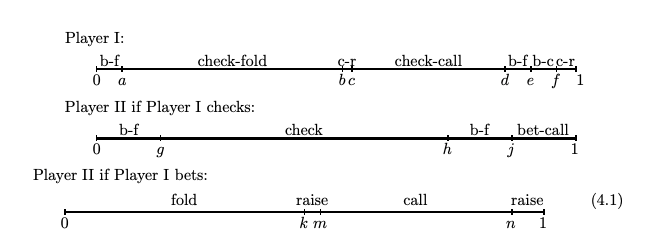
Indifference in poker is where reaction almost doesn't matter (+0 EV) because the action is balanced between good and bad hands. In the case below, all reactions (folding, raising, etc.) between [a] and [d] is a net zero EV against a pot-sized bet from an opponent with a lossless strategy.
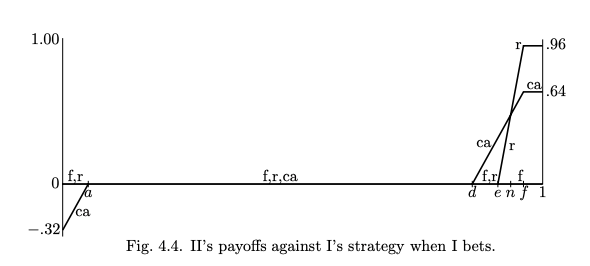
Partitioning hand strengths (distance between [a], [b], [c], [d], etc.) is a mental map that even beginners do ("I'm betting my strong hands"). Even though the ranges above don't take many things into consideration, it gives us a pretty good mental map to categorize ranges of hands.
According to the study above, it just so happens that against perfect opponents, our payoffs only exist when we have the nuts (or close to the nuts). This is why having the nuts, and/or likelihood to have the nuts (nuts advantage) is such an important edge.
What is a nuts advantage? A nuts advantage is having the higher likelihood of having the un-loseable hand. For example, on a 4s5c6d board, the big blind (having all the sets, two-pairs, and straights) will have the nuts advantage over a UTG raiser (having only overpairs).
Bluff catching against an opponent representing the nuts (think "big bet river") is a mini-game between the aggressor and defender.
Let's assume the aggressor has a range advantage. And that defender has a pure bluff-catching hand. The aggressor can almost bet with impunity. In fact, the bigger the bet, the higher bluff-to-value ratio, and the higher EV generated.
- Bluff-to-value ratio is calculated as above. bet/(bet+pot). For a pot sized bet, the villain can have 1 bluff for every 2 value hands. For an infinite-sized bet, the villain can have 1 bluff for every 1 value hand.
- This is very applicable because whereas it's hard have a range advantage on the river against a lossless opponent, we can identify spots where a villain just simply cannot have the nuts on the river. (e.g. a villain never betting backdoor draws, but a draw getting there on the river.)
- Note that this is contingent on villain having purely bluff-catchers (i.e. the aggressor has the only possible nuts).
On the contrary, once the defender starts having some nuts, the size and frequency of the overbet / nuts represention greatly diminishes.
- Though it's obvious, it's pretty eye-opening for me.
- This video done by BlackBaron is great. It's the main inspiration for this blurb. Against a trap-frequency of 20%, 4x over-bets become unprofitable, etc.
4. Pre-flop
This section is a very quick section just so I can get it out of the way. Some heuristics on pre-flop:
- The lower the SPR (stack to pot ratio), the more we want to be in a position for immediate showdown. Hands like AsJc are great for immediate showdown. The higher the SPR, the more we want to hit "jackpot" hands, hands like 8s9s are great for deeper stacks.
- We should play more hands in position, and less hands out of position, especially in deep stack when we are not just immediately realizing equity.
- We are incentivized to raise or fold pre-flop, especially if 2 other players are already in the pot.
5. Part 1: Choosing a Subset of Flops & Range
OK! Now let's make a strategy. A poker player with a strategy is better than a player without a strategy. A strategy that is easy to understand is also easier to execute.
My goal is to have a subset of flops / turns, and have a static pre-flop range that tackles all these subsets.
Below is a screenshot from a previous post I made. It describes how different hand combos (10%, 21% range, etc.) interact with different flop textures. Again, not meant to be exact, but just to get a good idea. For example, we can check range with no regrets on a 5d6s7s board as UTG against button call.
These ideas align with solver solutions.
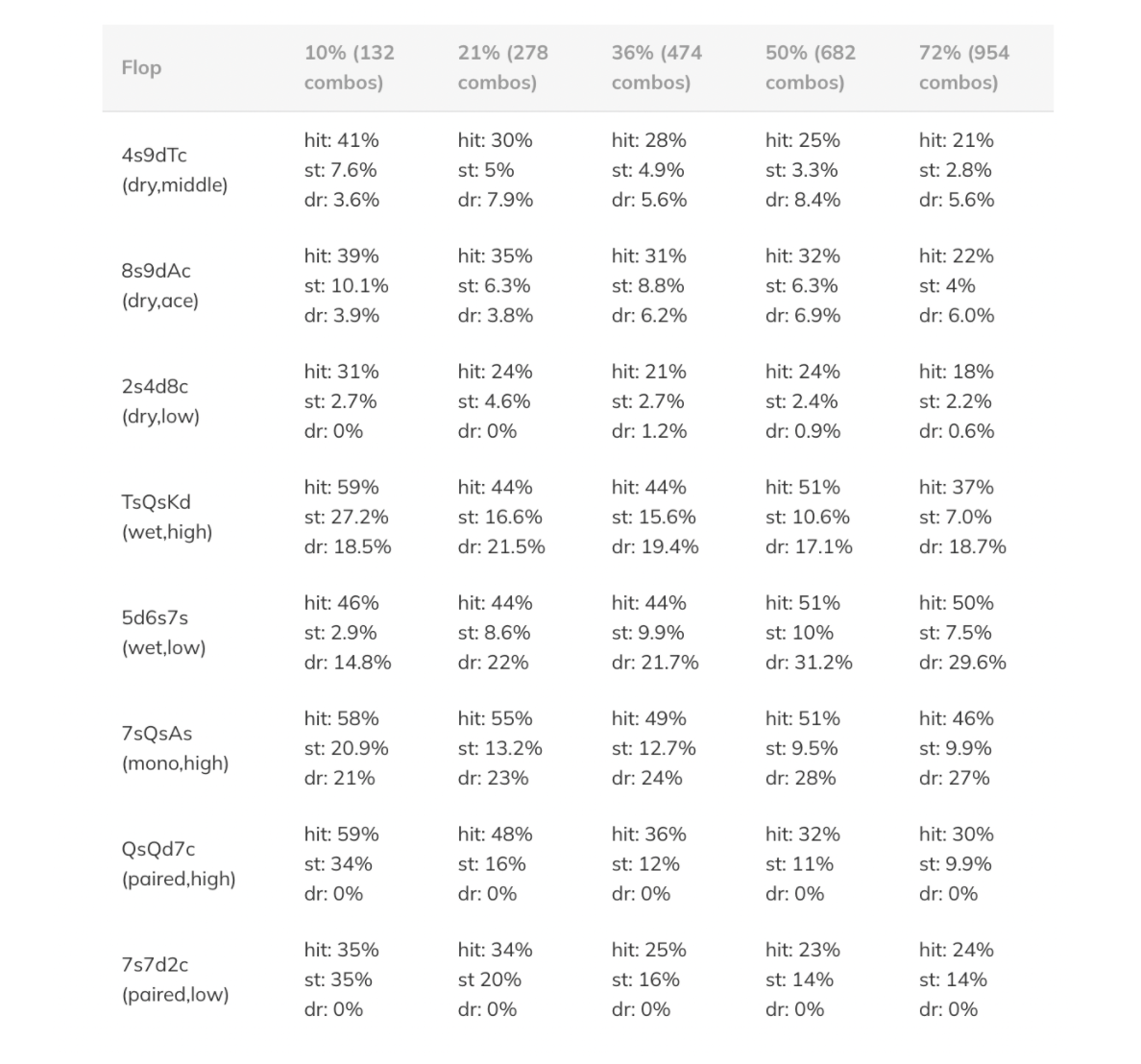
There are a lot of different ways to describe boards: (1) trips, paired, unpaired, monotone, two-tone, rainbow, (2) AHML (ace, high medium low): e.g. AML (ace medium low) (pg. 338)
Here's my tiny (5) subset of flops I have decided to use (in the future I may add to this list). I disregarded paired rainbow and trips as those happen quite infrequently.
- Unpaired Rainbow:
Ac8s9d(AMM)Qc5d2s(HLL) - Unpaired Two Tone:
JdTs4s(MML) - Monotone:
QsTs7s(MMM) - Paired Rainbow:
- Paired Two Tone:
7s7d5s(MML) - Trips:
Here's range 1. I refer to this as Range 1 or R1 later. There are 170 hands here and usually 150-ish with removal effects.
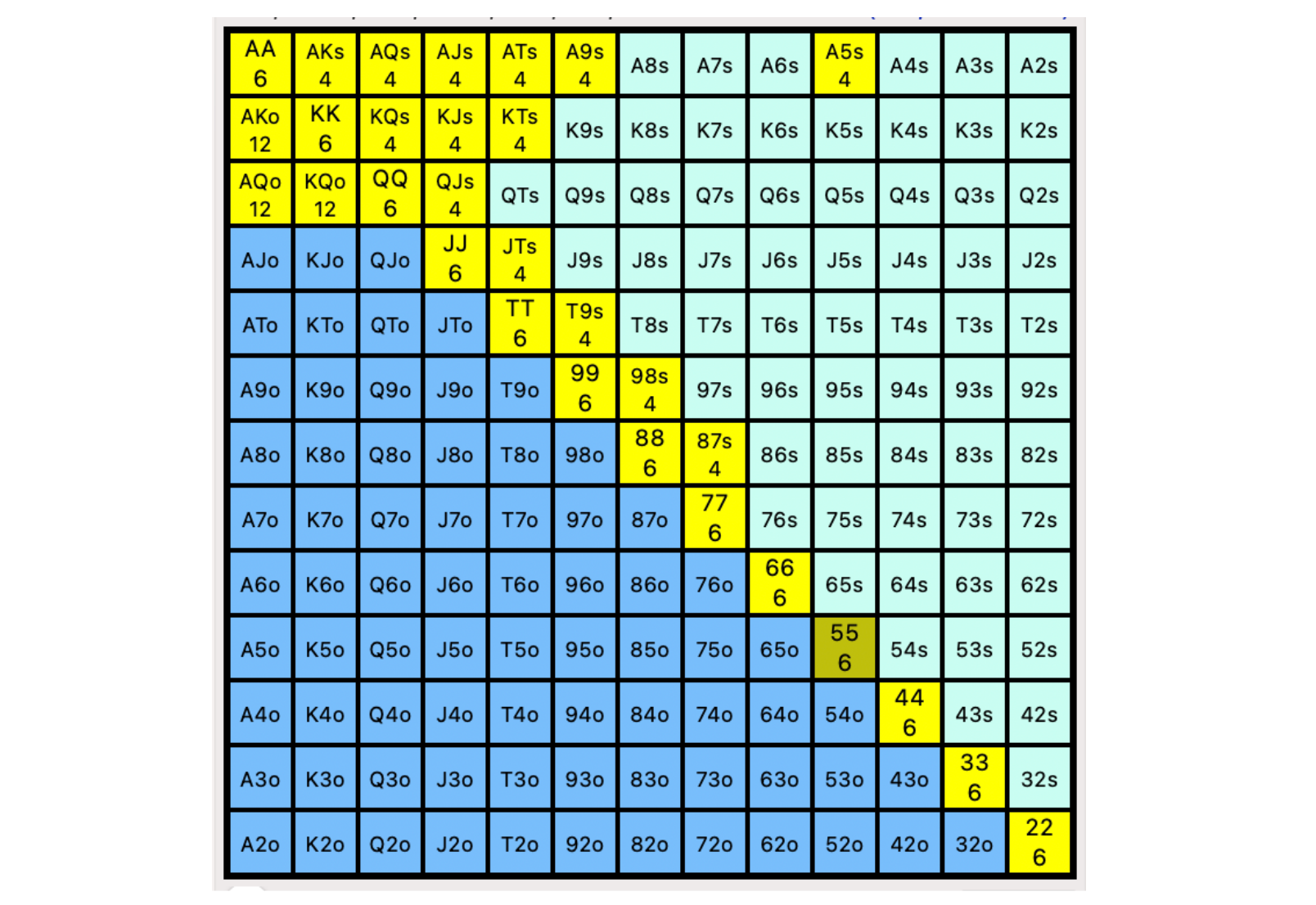
22+, A9s+, A4s-A3s, KTs+, QJs, JTs, T9s, 98s, 87s, 76s, AJo+, KQo
EDIT: afterthought: I should remove some lower pocket pairs in this range as these lower pairs are often at the bottom of equity.
Here's range 2 (400 hands). I refer to this as Range 2 or R2 later. I don't really write about this range but I use it as an example of a weaker villain range later.
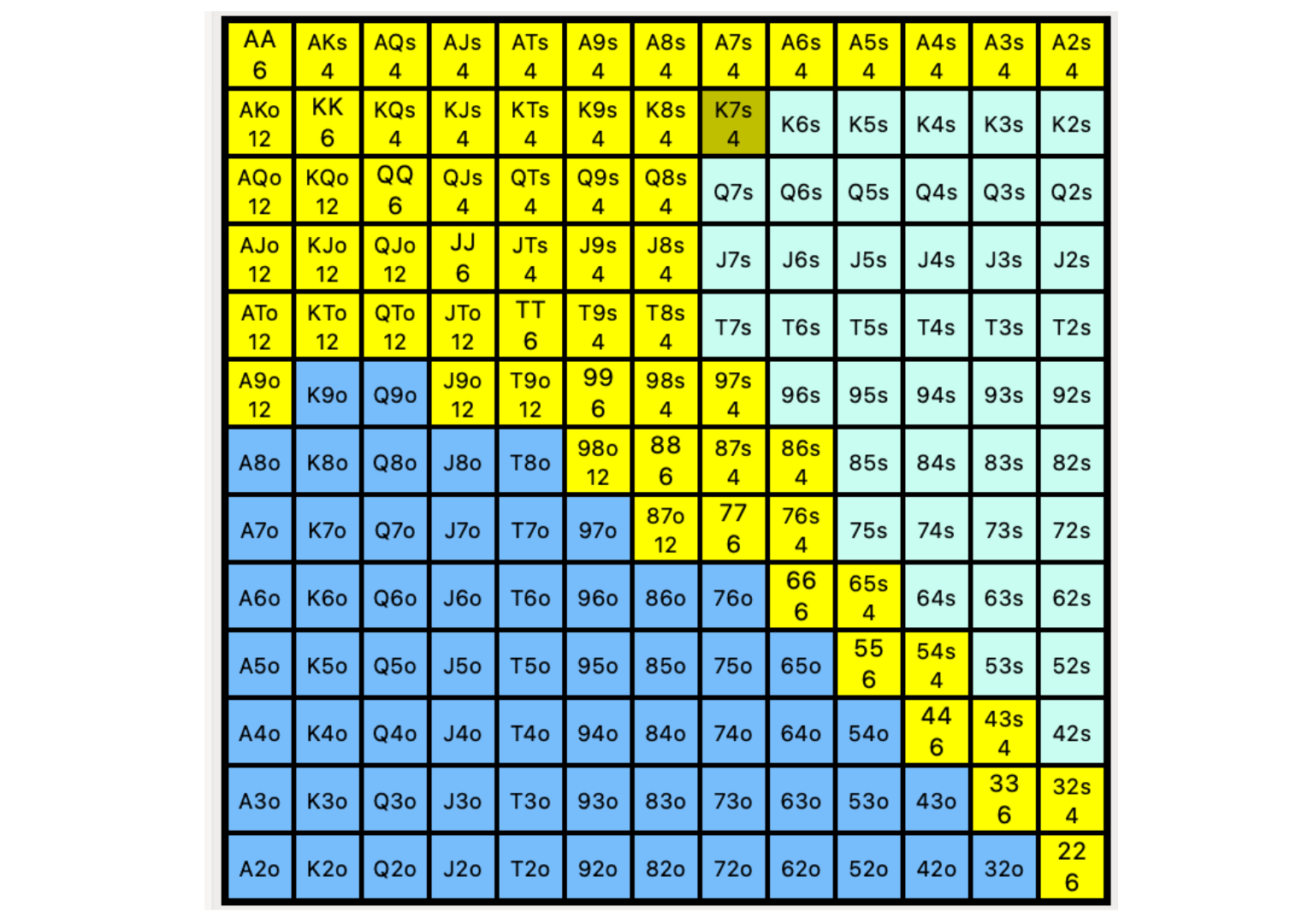
22+, A2s+, K7s+, Q8s+, J8s+, T8s+, 97s+, 86s+, 76s, 65s, 54s, 43s, 32s, A9o+, KTo+, QTo+, J9o+, T9o, 98o, 87o
6. Part 2: Flop, Turn, and River
Let's take a look at each flop, choose a bet size, and pick hands to bet, defend. I am doing this without a solver because I don't need a lossless strategy. I just need something that makes sense to me. Don't want to be someone that spews abstract nonsense post hoc poker hands.
Though it's not correct to, I just choose a bluff portion based on the formula based on the nut advantage bluff ratio. It's more correct to target a villain calling range and choose a +EV range to bet with (though this is more difficult).
For a half pot bet, I'm using b/(2b+p) => 1 bluff for every 3 value.
For a full pot bet => 1 bluff for ever 2 value.
Our betting frequency ought to be a function of the EV of our opponent's range in comparison to our own. For example, against a massively worse range, we should bet range. Against a symmetric range, I think betting half the time is fine. Against a tighter frequency, we should rarely bet. Once we can put our opponent's on ranges, we can think about what hands we are folding out, and if we are +EV against the remaining hands.
R1 = Range 1, R2 = Range 2
6.1 Ac8s9d
Ac8s9d X R1 X Flop
We have 170 hands (removal effect leaves 144), 36 top pairs.
How do we count these 170 hands? Let's pre-count them so it's easier at the poker table.
- 6 are suited Aces (12 combos) - pair
- 3 are unsuited Aces (24 combos) - pair
- We hit 6 combos of 2 pairs (A8s, A9s, 89s)
- We hit 9 sets
- We make 4 straight draws (TJs), maybe 8 if we also want to sneak 67s in this range.
We can bet range against a weaker range since this Axx flop favors our range, which will be most of the time. So the below consideration is considering a symmetric (or unknown) range.
strong hands <---> weak hands. Some considerations:
- I do not have a check raise range because that is too difficult to construct. If I want to polarize, I can polarize with overbets on the river.
- I'm betting 40% of the time. I also want my value to bluff ratio to be 3:1. I also want a substantial check call portion.
- Folding is a function of opponent's bet sizing and opponent's relative range strenth. To make the math easy, let's fold 50% of the time we check to our opponent. This is likely an overfold, but most opponents don't overbet anyway.
- Our range is so strong there aren't actually any floats.
cr is check raise, bc bet call, etc., pretty self-explanatory.
[cr 0] - [bc/bf 30] - [cc 30] - [cr 0] - [cf 30] - [bf 10]
This is just a rough construction of ranges I want to use. For example, if someone is folding too much, we can add some hands from cf to bf. If someone is calling too much, we can either use a bigger bet size with our value hands, or we can move hands from bf to cf, and hands from cc to bc/bf, etc.
If our opponent's range is much weaker, we should be betting range. Most of our opponent's hands don't hit whereas most of our hands are 22+ or better.
Though, I would imagine my strategy below is more suited for symmetric-y ranges.
Here how we can group our worse hands:
- 22, 33, 44, 55 66, 77 etc. (36 hands)
- KQo (12 hands)
- KQs, KJs, KTs (12 hands)
- QJs (4 hands)
- Hands that hit the board but are not strong: 78s (3), 9Ts (3), TT (3), JJ (3), QQ (3), KK (3)
What hands are we betting as a bluff (bf) or check folding (cf)?
This part of our range should be the weakest 40% of our range. (60-70 hands)
Perfect, we can just use:
- 22, 33, 44, 55 66, 77 (36 hands)
- KQo (12 hands)
- KQs, KJs, KTs (12 hands)
- QJs (4 hands)
I'm can use 22, 33, 44 (18) as bf candidates, and the rest for cf.
What hands are we betting for value (bc/bf) or check calling (cc)?
These are our value hands, the stronger 60% of our range. (90-100 hands)
- Sets: AA, 88, 99 (9)
- Two pairs: A8s, 89s, A9s (6)
- AXs: AKs, AQs, AJs, ATs, A5s (15)
- AXo: AKo, AQo (24)
- KK, QQ, JJ, TT (24)
- Weaker hands: 78, T9, JT, QJ
Or any hands that we don't have in the bf/cf range.
We are bc/bf half of these and cc the other half. The second hand of watch >= 30, we can bet, and if < 30, we can check.
What hands are we betting when we are checked into?
Same as before. Too lazy so I have same IP/OOP strategies.
What hands are we calling when bet into IP?
If it's something like HJ vs BB call, and BB is betting into us (BB shouldn't be betting), we can probably just always continue.
If it's something like HJ vs MP, and HJ is betting into us, we can continue % that makes sense in terms of MDF. Our range should be strong enough to not need floats.
- Sets and two pairs (15 hands)
- AX (39 hands)
- 78, T9, JT, QJ for coverage for potential nuts (14 hands)
- KK, QQ, JJ, TT (24)
This is about the 90 - 100 we are using for our bc/bf + cc range. Great, less things to mentally group!
Ac8s9d X R1 X Turn/River
The hand range that we end up with by betting and being called, and check calling (or calling IP), are different.
- Calling range is 60% value (bet at 30% of the time)
Obviously we can have new sets and combo draws. We can take the few combo draws to bluff, and the top half+ of hands include sets, two pairs, AX. We should drop everything else. - Betting range is 60% value (bet at 30% of the time) + 10% bluffs
Same as calling range to make things easy. I don't want too many bluffs.
I really like this 30-30-30-10 distro I am using. It's a good flow chart to use in unknown situations. Is this the bottom 10% I want to bluff? no -> Is this the strongest 60% of my range? yes -> bet half the time.
On the river, if, after turn bet/call action, we can polarize our hand.
If we have 4 possible combo of nuts, we want to bet 2 of them all-ins, and 2 of them "conventionally sized" at a 100bb (not sure, though, the higher the bb, the less hands we can jam). We also want to think about bluffs we can use. If the all-in size is "3x" pot, the bluff to value ratio is b:b+p (3:4), which means that if our 2 combos of all ins, we can try to think about the 1.5 combo of bluff we may have.
- For example on a Ac8s9d2d4c, maybe the all-in hands are AsAh, AsAd, Ah,Ad, and the bluffs could be As5s, Ah5h (block AX, not Ad5d because we would unblock missed flush draws).
- If our opponent/table is overcalling, we can construct a larger all-in range. For example, we can all-in all the sets, which would be 9 hands, and bluffs can be As5s, Ah5h, As9s, Ah9h, AsTs, AhTh. Etc (6 hands). If a specific player is undercalling, maybe we can sneak in a few more bluffs.
Our poker strategy isn't really that spectacular, but it's pretty nice; it will be much easier coming up stuff from here.
Let's look at other flops.
6.2 Qc5d2s
Qc5d2s X R1 X Flop
[cr 0] - [bc/bf 30] - [cc 30] - [cr 0] - [cf 30] - [bf 10]
One thing to note: this flop is much stronger for stronger ranges. We hit less often, but also, our opponent hits even less often.
What hands are we betting for value (bc/bf) or check calling (cc)?
Stronger 60% (90-100)
- sets: QQ, 55, 22 (9)
- 2 pair: (0)
- overpair: AA, KK (12)
- top pair: AQ (16), KQ (16), QJs (3)
- middle strength pocket pairs: JJ, TT, 99, 88, 77, 66 (36)
As before, we bet half the time and check half the time, unless we are checked to.
What hands are we betting as a bluff (bf) or check folding (cf)?
Weaker 40% (60-70 hands) - everything not in strong range
- weak pocket pairs: 44, 33 (6)
- AX that doesn't hit: AK (16), AJs (4), ATs (4), A9s (4), A5s (4)
- KX that doesn't hit: KJs (4), KTs (4)
- Everything else that's garbage: suited connectors (16)
As before, a fourth of these needs to be bf candidates: I nominate all AK combos (16)
For dry KLL (king - low -low) boards, I can nominate AQ combos for bluffs. Though for dry KMM (king - medium - medium) boards, I want to keep what I was doing before for AXX, have 22, 33, 44 (18) as bluffs as these have way better implied odds.
Qc5d2s X R1 X Turn/River
Same as before, we can start chopping off our middle strength pocket pairs. We can remove some top pair bad kicker hands if we really start removing more hands.
6.3 JdTs4s
JdTs4s X R1 X Flop
I like thinking of flops as different "adventures". Whereas dry flops are straightforward hike trails, JdTs4s is a bit more for the intrepid spirit. We probably want to start choosing hands with good visibility rather than sheer equity. For example, on this flop, AsKs has more visibility than AdTd, though AdTd has higher equity. Choosing hands with greater visibility is more important OOP and at deeper stacks.
We want to check some strong hands or else our calling range is too weak. For the above dry flops, we solved this problem by taking the top 60% of hands and just choosing to bet half the time and check half the time with these hands. We have to be careful though because we only have a 52-53% equity on this unpaired two-tone board (with our R1 range, 150 hand combos with removal effects) against a 400 combo range (R2), whereas we were enjoying a 60% plus equity against a 400 combo range in our previous two flops.
Therefore, I think I'm going to solve this problem by always checking OOP, and betting only IP with a pot sized bet.
[bc/bf 40 hands] - [cc *] - [cf *] - [bf 20 hands]
What hands are we betting for value (bc/bf)?
39-40 hands
- Sets: JJ, TT, 44 (9)
- Two pair: TJs (2)
- Overpairs: AA, KK, QQ (18)
- Flush draws: KsQs, 9s8s, AsKs, AsQs, AsJs, As9s, As5s, KsJs, QsJs, 7s8s (10)
Unliked our strategy for dry boards, we are always checking OOP, which means that we are always betting the above hands.
What hands are we betting as a bluff (bf)?
Pot sized bet implies 18-20 hands of bluff, but also don't think we should be bluffing a lot because our flush draws we are betting for value aren't actually for value. A hand we're betting for value like 7s8s has as much equity as a hand like 9s9h (50-51%), a hand we're betting as a bluff.
- Backdoor nut flush: AsKcdh, AsQcdh (6) -- also happen to be gutters
- Open ended + backdoor flush: KsQcdh (3)
- Maybe 9s9x, 8s8x, 7s7x (9) if we want to add more bluffs.
I should be taking hands to balance the coverage of runouts, but fuck it; my opponents aren't clairvoyant. I only define bluffs as hand we don't mind folding. I'll just be taking the strongest backdoor draws as my bluffs. These should be easiest for visibility and equity calculation.
What hands are we check calling (cc)?
Calling should be just simple defense. The larger our opponent's bet, the less of our range we continue with; we can juse use MDF. We can just start chopping from these hands.
- Sets: JJ, TT, 44 (9)
- Two pair: TJs (2)
- Overpairs: AA, KK, QQ (18)
- JX with no flush draw: AJ, KJ, QJ (9)
- Combo flush draw: KsQs, 9s8s (2)
- AX Flush draws: AsKs, AsQs, AsJs, As9s, As5s (6)
- Other flush draws: 7s8s (gutter) (1), KsJs, QsJs (pair + flush draw) (3)
- Open Ended Straight draws that we haven't counted before: KQ (3), 89 (3)
- Backdoor nut flush: AsKcdh, AsQcdh (6)
- Other uncounted pairs: AT (3), KT (3), 99, 88, 77, 66, 55, 33, 22 (42)
Note that there are weak visibility hands here like AdJd that we call with that we don't bet with.
JdTs4s X R1 X Turn/River
Unlike for the previous 2 flops, we don't really make any adjustments against weaker ranges on this board because weaker ranges have many more nuts.
Our check calling range is very different from our betting range. Given our strong betting range, a clairvoyant's opponent's calling range could also be strong. Below isn't a deterministic game plan, but just general considerations:
What if the turn is a spade?
We have 10 combos of flushes.
Unless we really need protection (e.g. against many people), I don't really need to donk. We can pretty straightforwardly play this in position. We have 29 combos of sets, two pairs, overpairs, and 10 combos of flushes that we can comfortably call (if not raise) with. We can also call some backdoor nut flush draws (6). I don't mind calling not raising non-nutted flushes for protection because (1) our flushes are all actually quite strong and (2) reverse implied odds and (3) more river protection.
What if the turn is not a spade?
If it went check check on the flop, we can consider donking turn, though we don't really need to donk.
After a second round of betting, we should comfortably hold 29 hands of sets, two pairs, overpairs, and 10 hands of flush draws. Though, we may need to find some other strong hands to call with, and we can include some JX hands (9).
What are river jam considerations?
We are always jamming the nuts. I can count the number of what I consider to be the nuts, and then work backwards to count the number of bluffs we can hold.
For example,
- if we have 5 nut flushes, and a 3x pot bet is all in, then we need 3/7 bluffs, maybe AsKh and AsKc can be the bluffs.
- if we have 6 full houses, and a 2x pot is all in, then we need 2/5 bluffs, maybe some full house blockers, trips or two pair type hands
6.4 QsTs7s
QsTs7s X R1 X Flop
Theory says monotone flop favors weaker calling ranges, and bet size should be small and infrequent. We only have a 16.8% hitting a flush on this board, whereas R2, a 400 hand range, has a 17.6% chance of hitting a flush. I'll look at a third pot bet.
Out of our 150 hands, only 6 are flushes. The QT on the board are blocking some of our flushes. If it's three low spades, then we'd have so many more flush draws, 6 AX flush draws, 3 KX flush draws, 1 QJ, 1 JT, 1 T9, 1 98, 1 87 (14 total).
What hands are we check calling (cc)?
- Sets: QQ, TT, 77 (9)
- Two pair: (0)
- Overpairs (no flush draw): AdAc, AhAc, AhAd, KdKc, KhKc, KhKd (6)
- Overpairs (flush draw): AsAdch, KsKdch (6)
- Other nutted flush draws: AsKdch (3)
- Top pair (no flush draw): AdchQdch, KdchQdch, QJs-dch (21)
- Flushes: AsKs, AsJs, As9s, As5s, KsJs, 9s8s (6)
- Other flush draws + Pairs: JsJcdh, 9s9cdh, 8s8cdh, 66-22 (27)
- Other pairs: ATdch (3), KTdch (3), JTdch (3), 78dch (3)
This is about 90 hands, 60 made-ish hands, 30 drawing hands. Ok to call less because a lot of hands have little with our hand.
What hands are we betting?
21 hands, with a third pot bet
- Sets: QQ, TT, 77 (9)
- Overpairs (flush draw): AsAdch, KsKdch (6)
- Flushes: AsKs, AsJs, As9s, As5s, KsJs, 9s8s (6)
What hands are we bluffing?
A 1/3 pot bet implies a bluff portion of 1/5, which means 4 hands of bluffs.
- Nutted flush draws: AsKdch (3), AsQdch (3)
QsTs7s X R1 X Turn/River
We really want to be having flushes or nutted flush draws given more rounds of betting, though we don't have very many combos. Our value / bluffing candidates are same as the candidates for the JdTs4s hand.
On a non-spade turn, non flush drawing hands suddenly become a lot stronger. Some middle pairs with no flush draws can consider calling.
Though, on a spade turn, 45% of hands are flushes. A hand like 2c2s suddenly beats a hand like AhAd. We can consider folding out all of our non-flush hands after a bet, though we can keep sets and two pairs.
6.5 7s7d5s
Here are the groupings:
- Quads: 7c7h (1)
- Full house: 55 (3)
- Trips: 78s (2)
- Overpairs: AA-88 (42)
- Flush draws (12)
The above hands can probably withstand 2 rounds of betting.
Pretty self explanatory, too lazy to write more, but I think a small bet size is sufficient because equities are likely not close. We can treat the distributions similar to a dry AXX board.
7 Multiway
This is more of a continuation of the second section. According to this, "the exact optimal defend frequencies in multiway-pots are a matter of debate, and are still undiscovered due to vast variables." That being said, I think this is a nice tool.
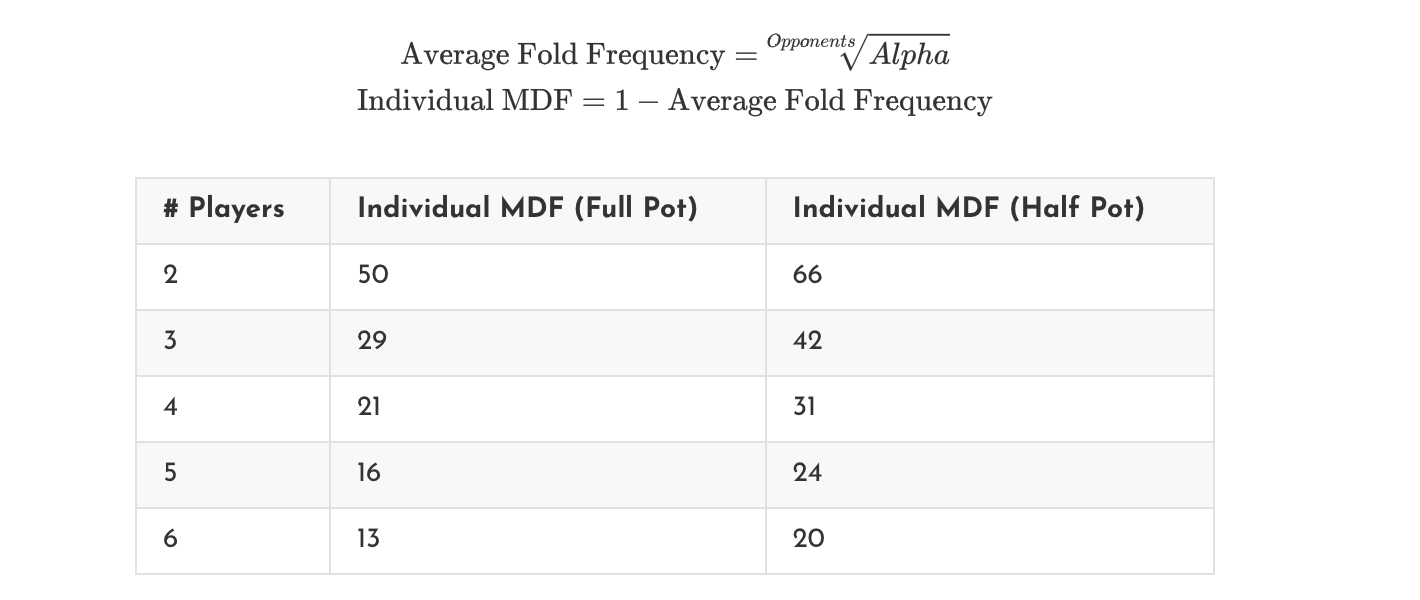
So, for example, against one other player, we should defend 50% of the time for a pot-sized bet, though against 6 other people, we should only defend 13% of the time. In examples of our strategy above when we were taking 50% of our range, perhaps we only need to take 20% of our range in multiway pots.
As the aggressor, we should expect to generate less and less fold equity the more people we are playing against. If you know everyone's folding frequency, you can also multiply to get a combined fold frequency. Though I have no idea how to do that at the poker table.
Basically, we should just play our hands more conservatively: (1) fold more because people are likely stronger when betting assuming clairvoyance in strategy and (2) bet less because a bet is more likely going to be called.
Aside: Our bluffs in multiway spots should be really be kept to a minimum, more so than the charts suggest. Most players in multiway spots don't have bluffs and are continuing with value.
8 Being humans
8.1 Some tendencies
- Most players overvalue premium pre-flop hands in deep stacks.
- Most players don't bluff catch on river facing large bets. We can apply pressure against these players for more fold equity
- Most players call 3-bets too often
c bet more if not calling
3-bet more with value hands - Most players under-bluff very dry or very wet. This is my own hypothesis.
8.2 Live Tells
Looking for tells is something I'll need to do more. These live tells/suggestions are purely taken from internet lists.
- strong means weak, weak means strong in general
unless opponent has a history of reverse tells
reaching for chips, pretending to raise but calling = weak - weak hand statements = strong
"I'm on a draw", "I don't think you have anything", "I was afraid you'd snap call" = strong - uncharacteristic personality
uncharacteristic attention to hand = strong (sudden posture straighten, asking "who's turn is it", etc.)
change in talking characteristic = strong (talkative player becoming quiet, quiet person becoming talkative) - bet sizing = strong/weak hands
- human nature
eyes looking at chips = want to bet
eyes staring at board cards = have not yet hit draw
freezing after bet = bluff
8.3 Under-bluffed & Over-bluffed Spots
And we go back to the Phil's example of what he thinks is an over-bluffed spot because so many draws miss. We can also leverage our experience (what we think of the population) to find over-bluffed and under-bluffed spots. Some post-flop aggro player is going to take spots to bet too much, for example, and we can capitalize this behavior on certain boards.
8.4 Poker Asides
There are also variants like short deck or PLO or forehead poker, etc., for when you wanna switch things up.
I would like to say thanks to HSP (commentated by Gabe Kaplan) for getting me interested in poker in the first place.
9. Results and Reflections
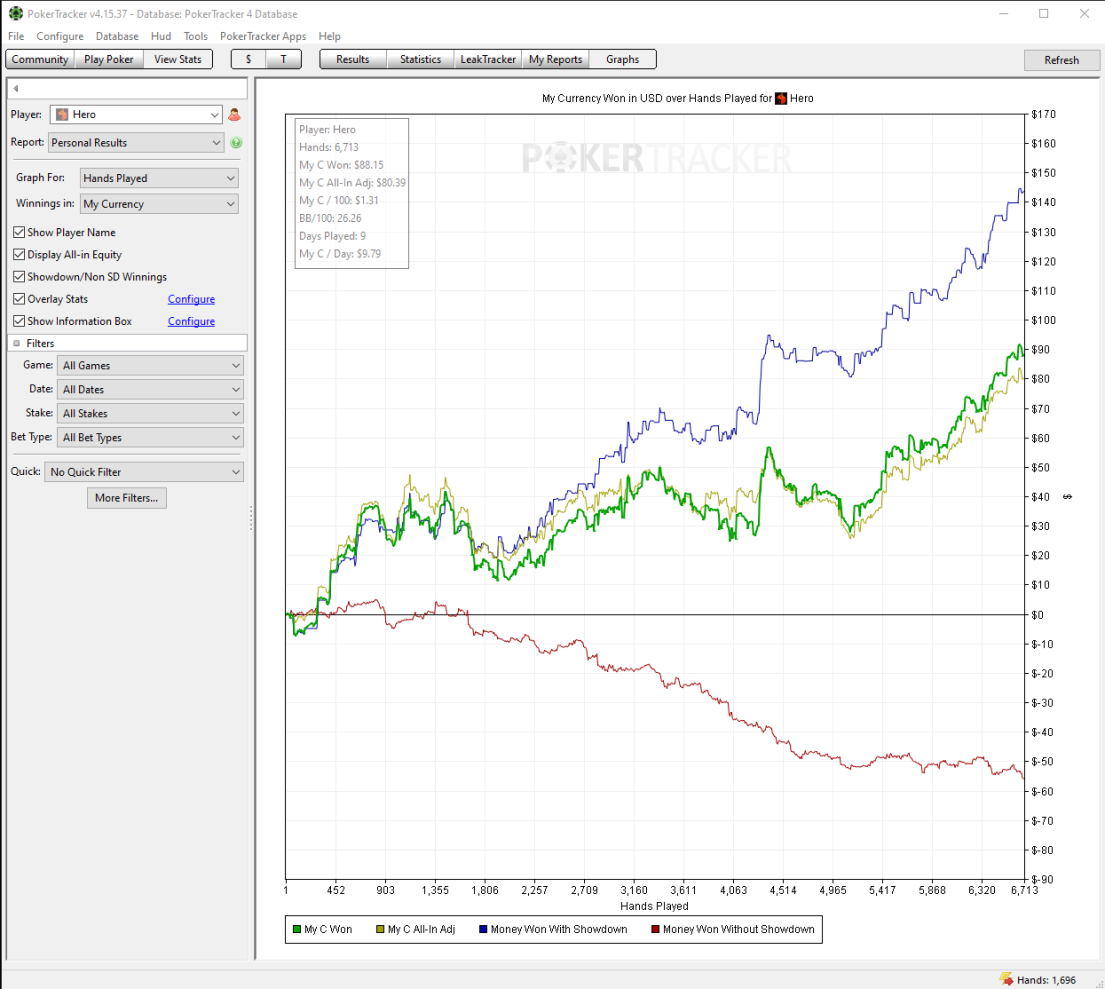
I haven't really played that much poker in the meantime, but here are some results. An extremely impressive 26.26bb/100 if I do say so myself. Though, still, a very low sample size.
I have a notepad / Pokertracker4 HUD up when I play. Here are some of my +EV suggestions.
- Get good at pre-flop. Always think about SPR.
- I don't really deviate from my pre-flop strategy, unless I'm about to call instead of re-raise with a hand that's hard to play out of position against a sticky opponent.
- Most EV is won against by being in position of player with high AF/VPIP/fold-to-X-%.
- I find 9max to be the most profitable game because playing against people who are impatient is +EV.
- At an equilibrium, bluffs should be breakeven. But most players are value-heavy, and so bluffs should be (1) used infrequently, (2) large, and (3) mostly when you "should" have it. Going for it against tight/sticky opponents is -EV.
- In multiway pots: Bet much less frequently and have a way lower bluff to value ratio.
- Be aware of cheating signals. Always the same people VPIPing multiway in a hand, taking the same time to act every hand, etc.
Other things for me to think about in the future:
- Delayed c-bets on dry boards.
- Where to re-raise against people with wide ranges in under-bluffed/dry spots.
- Blocker bets sizing on the river.
I have finally finished this post after months. I have finally pressed "Update" on this post after much dust have collected.
I always get a lot worse after periods of poker hiatus. And yet, pauses in playing poker is quite necessary. I find that I'm a player that's easy to go on tilt. Even though playing a large number of hands can help mitigate tilting singletons, it can still be a debilitating experience.
There are two ROIs one can gain from poker.
- The first is purely the nominal gain of money. Poker has really bad ROI because of the sheer number of hands required to counterbalance the high variance. It's a bad return on invest on time, mental, and effort. And in the ends, only the house wins, pocketing an easy 5% rake after every hand.
- The second gain ROI is the less tangible gain of just enjoying the game and trying to get better at it. I have learned the rules of the game in high school, and haven't really played that much until now. I have gotten my fill from the game, and perhaps I will play some more, but in the meantime, that's pretty much it.